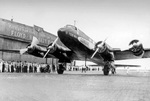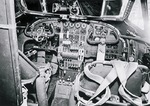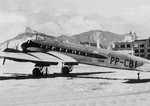Fw 200 Condor
| Country | Germany |
| Manufacturer | Focke-Wulf Flugzeugbau GmbH |
| Primary Role | Heavy Bomber |
| Maiden Flight | 27 July 1937 |
Contributor: C. Peter Chen
ww2dbaseOriginally developed as a commercial transport for Deutsche Lufthansa, the Fw 200 Condor aircraft first took flight in Jul 1937. The all-metal aircraft immediately attracted world-wide attention after being the first aircraft to fly from Berlin to New York non-stop on 10 Aug 1938, which resulted in orders from airlines in Denmark, Brazil, Finland, and Japan. The first military application of the Fw 200 design was in 1938, when Japan ordered a Fw 200 airliner to be converted as a reconnaissance aircraft; this aircraft was intended for the Japanese Navy, but it was never delivered because it was commandeered by the German Luftwaffe as the European War began. In 1940, a design based on the Japanese order was completed that converted Fw 200 into a bomber. This military design added hard-points under the wings for external bombs, a strengthened fuselage for an internal bomb bay, and gun turrets; because of the added weight at less-than-deal locations, the military conversions suffered break-up risks during landings. In Jun 1940 these military Fw 200 bombers began their maritime patrols. Within the next three months they had sunk over 90,000 tons of Allied shipping. Additionally, they also reported sightings of Allied shipping to Kriegsmarine U-boats. Despite the successes, they were used mainly in situations where combat was not expected because of an order from Adolf Hitler that their numbers must be preserved. After such an order, they started seeing more transport than combat duties. During the Stalingrad siege, Hermann Göring insisted that his transport fleet, which included many Fw 200 bombers, could deliver enough supplies via air to the German forces trapped in the city, but the quantity delivered never met the level of supplies needed. By late 1943, they were used almost exclusively as transports, particularly as the Ju 290 aircraft took over the reconnaissance role while Allied control of the Atlantic made maritime raids impossible.
ww2dbaseBy the time production ended in 1944, a total of 276 were built.
ww2dbaseSources: Aircraft of the Second World War, Wikipedia.
Last Major Revision: May 2007
Fw 200 Condor Timeline
| 11 Aug 1938 | A specially prepared Focke-Wulf Fw 200 Condor aircraft "Brandenburg" (D-ACON), flown by Deutsche Luft Hansa Captains Henke and von Moreau, landed at Floyd Bennett Field, New York, United States, having made the 3,958-mile nonstop journey from Berlin via Hamburg, Glasgow, Newfoundland and Halifax in a record-breaking flight time of 24 hours and 36 minutes. |
SPECIFICATIONS
C-0
| Machinery | Four BMW-Bramo Fafnir 323R-2 9-cylinder radial engines rated at 1,200hp each |
| Armament | 1x15mm MG, 1x20mm MG, 3x7.92mm MG, 1x13mm MG, 2,100kg of bombs, optionally carried 2 missiles |
| Crew | 5 |
| Span | 32.85 m |
| Length | 23.45 m |
| Height | 6.30 m |
| Weight, Empty | 12,951 kg |
| Weight, Loaded | 22,700 kg |
| Speed, Maximum | 350 km/h |
| Service Ceiling | 5,800 m |
| Range, Normal | 3,550 km |
C-3/U4
| Machinery | Four BMW/Bramo 323R radial engines rated at 1,200hp each |
| Armament | 2x20mm MG 151 cannons, 6x7.92mm machine guns, 1x13mm MG 131 machine gun, up to 3,000kg of bombs as bomber or 30 fully-armed soldiers as troop transport |
| Crew | 5 |
| Span | 32.85 m |
| Length | 23.45 m |
| Height | 6.30 m |
| Wing Area | 119.85 m² |
| Weight, Empty | 12,950 kg |
| Weight, Maximum | 22,700 kg |
| Speed, Maximum | 360 km/h |
| Service Ceiling | 5,800 m |
| Range, Normal | 3,556 km |
| Range, Maximum | 4,440 km |
Photographs
 |  |  |  |
Did you enjoy this article or find this article helpful? If so, please consider supporting us on Patreon. Even $1 per month will go a long way! Thank you. Share this article with your friends: Stay updated with WW2DB: |
Visitor Submitted Comments
3 Aug 2011 11:13:23 AM
NERVE GAS: THE BALANCE OF TERROR
The world's first types of Nerve Gas/Chemical
weapons, were developed by the Germans the first was Tabum in 1936, Sarin in 1938 and Soman in 1944 these weapons were more lethal than earler ones.
An agent such as Mustard Gas injures and kills by burning the skin and tissue.
Nerve Gas causes total muscle paralysis paralising the muscles that help the body breath.
STRANGE AS IT MY SEEM:
The Allies were far behind the Germans in chemical weapons development, and were more deadly than the stockpiles of Chemical agents the Allies had. German intelligence was unaware the Allies had not developed similare compounds, but speculated they might have. The Allies knew nothing of the German Nerve Gas Weapons, or that the German army had stockpiles of artillery shells for use.
HIDDEN WEAPONS OF WAR:
Hitler felt that if Nerve Gas was used in combat or against civilian targets the Allies would retaliate and assumed that the Allies had the same types of weapons. After
WWII the Allies and the Russians captured stockpiles of these weapons along with the scientists, engineers and technicians and continued research into more dedly and advanced chemical weapons during the Cold War.
One victim of Gas attack, was Adolf Hitler who was temporally blinded, during WWI this
strange man sitting in his bunker in Berlin in 1945, could have used such weapons against the Allies and the Russians closing in on the 1,000 year Reich.
Hitler adamantly refused to authorize the
use of such weapons on the battlefield.
However, such agents and other devices were used such as Carbon Monoxide and Zykon B were used against civilians in extermination camps.
Restricted documents both German and Allied
would prove each side had the means to deliver such weapons, if attacked first.
During the planned invasion of Japan the US
was planning to use Nerve Gas against the Japanese, could the agents have been captured German Gas Weapons?, we'll never really know.
12 Jan 2014 02:17:25 PM
DESPERT HOURS:
Heinkel's "Wespe" (Wasp) was design as a VTOL
Vertical Take Off and Landing single-seat fighter
powered by 1 x He S201 turboprop driving six bladed contra-rotating propellers the machine was designed around a circular wing the pilot sat under a bubble canopy and it was armed w/2 x 30mm cannons and 4 x-4 air-to-air missile.
Like most other German wonder weapons, the Waspe VTOL aircraft never went into production.
INTELLECTUAL PROPERTY:
The United States along with its Allies found and recovered thousands upon thousands of tons of documents, research papers, blueprints and other scientific data at wars end. The grand prize was thousands of German scientists, engineers and other skilled technicians brought to the US after the war, to continue their research. Germany was drained of all its scientific, industrial and military secrets, including German patents.
SOMETHING OUT OF FLASH GORDON:
The Germans had plans for a long-range rocket powered bomber. The craft was designed to bomb New York from Germany and return, flight time to its US target, was 40 minutes!
It would be launched by a catapult system to a speed of 500mph when its fuel used up, it would glide to the target, bomb and return to Germany.
SECRET WEAPONS COPIED:
Jet and rocket engines, ramjets, infra-red devices
swept wing, missiles V-1 and the V-2, submarine technology, television guided weapons. air-to-air weapons, nerve gases, advanced infantry weapons, synthetic fuel and medical technology the list is endless.
In my comments ww2db, I'll continue to research for verifiable facts, just saying that so-and-so told me isn't good enough.
ABOVE TOP SECRET:
Speculation over German wartime research and weapons development continue to this day decades after the end of World War II.
Sources requesting such information have been led into endless circles, for such information.
Government agencies have files away thousands of documents that are still kept as sensitive, while others have been released and known to the general public.
4 Dec 2014 07:20:18 PM
THE STUFF SCIENCE FICTION IS MADE OF:
Focke-Wulf Flugzeugbau "Flat Riser" was a drawing
board paper project. However reports of such a craft being developed by a research team in Prague, Czechoslovakia near the end of the war were these vehicles one in the same?
Let's get back to the Focke-Wulf project as far as known it never went beyond the design stage.
It was intended to be a (VTOL) Vertical Takeoff and Landing aircraft. Didn't need a runway, and could be hidden anywhere. This was just a proposal
I don't know if a wind tunnel model ever existed
or survived.
RIGHT OUT OF BUCK ROGERS: CONTROLLED FLIGHT
The Focke-Wulf "Flat Riser" was circular in design
the center section had two large horizontal propellers installed and rotated in opposite directions, with one vertical tail assembly, the cockpit was ahead of the fuselage giving the pilot
a good view fore and aft the aircraft had two main landing gears that retracted into the fuselage and one single tail wheel.
Flight could be controlled by direction of the exhaust gases from a gas turbine so you wouldn't need conventional control surfaces like a rudder, ailerons or elevators, that you see on a conventional aircraft
Turn and bank the pilot could reduce power or the pilot would increase power to one of the two propellers much like that of a helicopters tail rotor reduce power and the helicopter turns to the right increase power the helicopter turns left, I'm sure the craft would run into stability problems, but I'm only guessing here. What other
secrets are filed away in US Government archives. If anyone has more information post it here as I would like to know more myself...
6 Dec 2014 12:04:36 PM
HITLER'S FANTASY ARSENAL: COMMENT # 11
FOCKE-WULF "FLAT RISER"
For additional information about this aircraft click on center photo of the Focke-Wulf FW 200 Condor, and scroll down to comment #11 Were these two craft one in the same?
WARTIME R & R: RESEARCH & DEVELOPMENT
Were any schematic drawings and other technical data captured? was even a prototype built? or was the prototype destroyed in a test crash?
Did you know in 1939 a saucer like craft with two enclosed rotors was developed. Professor Heinrich Focke was interested in helicopter and autogyro technology he studied new designs during the war, and with the development of the jet engine would lead his design team to study the turbo-shaft engine.
As the decades pass since the end of World War II as new information becomes available, WWII still holds many secrets to unlock.
25 Feb 2016 01:40:11 PM
THE FIGHTER THAT NEVER WAS:
The Messerschmett Me 329 was a design project for a heavy fighter and ground attack aircraft.
Development for this design a low-priority However, a full scale glider was built and tested
during the winter of 1944/45 work on the project was later cancelled due to the war situation.
The Me 329 was of advanced flying wing design
powered by 2 x Daimler Benz DB 603 engines with twin pusher type propellers the engines were buried in the wing. The pilot and navigator sat in tandem under a long canopy, the fuselage blended into the wing, with a vertical tail.
PROPOSED ARMEMENT: HEAVY HITTER
The Me 329 was to have been armed w/4 x 20mm cannons in the nose, 1 x 20mm cannon in the tail and 2 x 30mm cannons in the wings.
The Me 329 could carry up to 2400kgs of bombs
14 Oct 2016 06:34:35 PM
ANOTHER WUNDERWAFFEN:
The Focke-Achgelis Fa 269
was a proposed single-seat VTOL fighter. Designed with tilt-rotor system.
The idea was to have the rotors swivel 80 degrees backward, to become a pusher type aircraft, To clear the ground, the Fa 269 was designed with long landing gear legs and tail that would retract into the fuselage.
TIME RUNNING OUT:
The Fa 269 never went into production but a wind tunnel model was built. The program received a set back and was later cancelled after the prototype was destroyed in an Allied bombing raid.
The Fa 269 was to have been armed with 2 x 30mm cannons...
18 May 2018 03:04:39 PM
the type of bombs that was carried
All visitor submitted comments are opinions of those making the submissions and do not reflect views of WW2DB.
- » WW2DB's 20th Anniversary (29 Dec 2024)
- » Wreck of USS Edsall Found (14 Nov 2024)
- » Autumn 2024 Fundraiser (7 Nov 2024)
- » Nobel Peace Prize for the Atomic Bomb Survivors Organization (11 Oct 2024)
- » See all news
- » 1,150 biographies
- » 337 events
- » 44,024 timeline entries
- » 1,241 ships
- » 350 aircraft models
- » 207 vehicle models
- » 375 weapon models
- » 123 historical documents
- » 260 facilities
- » 470 book reviews
- » 28,586 photos
- » 432 maps
Winston Churchill, on the RAF
Please consider supporting us on Patreon. Even $1 a month will go a long way. Thank you!
Or, please support us by purchasing some WW2DB merchandise at TeeSpring, Thank you!
14 Jan 2011 08:53:19 PM
WHY CHEMICAL WEAPONS WERE NOT USED AGAINST THE ALLIES:
Before World War II the Germans created new
poisons tabun and Sarin, Hitler assumed the Allies had similar agents, and if used by Germany, the Allies would retaliate in all out chemical warfare.
After World War II the Allies were shocked to
learn how far behind they were in this technology.
WORLD WAR II LEFTOVERS:
During the Cold War both the USA and the USSR
put enormous resources into the development of chemical and biological weapons.
Both the USA, USSR/Russia signed a bilateral treaty in 1990 to end chemical weapon production, and start destroying each nation's stockpiles that came into effect in 1997.
This treaty was honored by Russia, following the collapse of the USSR but all this is up front, what's underneath somebody is always working on something...
Reminds me of a cartoon I saw a long time age, but always remembered.
Two men carying all types of weapons on their person, one has opened the door to the
disarmament room saying after you, no the other says after you...